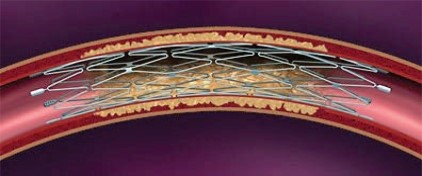Carotid Artery / Intracranial Stenting
Intracranial stenting
Intracranial stenosis is a narrowing of brain blood vessels. Most often, the narrowing is due to atherosclerosis, and a build-up of fat and other substances (plaques) in the blood vessels. When enough plaques build up or a blood clot develops, the artery can become blocked. A stroke can occur if the blood supply to the brain is disrupted. Strokes due to blockages of blood vessels can happen in two main areas: in the neck (main blood supply route to the brain) or in an intracranial artery (an artery within the skull).

Can any patient receive a stent?
Some patients who have intracranial stenosis have good results with medications like aspirin and blood thinners and by making lifestyle changes. Stent placement is recommended only for those experiencing symptoms along with severe intracranial stenosis that has not been benefitted by medical treatment. Severe intracranial stenosis is defined as 70% blockage or more. People with diabetes or who have blockages in arteries that cannot be accessed with a catheter are not good candidates for this procedure.
How does the doctor insert the stent?
Under angiography (a way to visualize the blood vessels), a catheter is inserted (usually in the groin) and then threaded through the arteries and in either the arteries of the neck or brain depending on the location of the problem. The stent delivery system follows the same path as the catheter, and thus, carries the stent to the treatment site. The stent is then placed. As it is positioned, it expands to conform to the inside contours of the artery wall. After placement, the catheter is removed and the stent stays in place. Stents act as a permanent implant that opens these blocked arteries, allowing improved blood to flow to the brain.
Compared with the carotid arteries, the arteries inside the brain are very small and make a lot of twists and turns, so they’re somewhat difficult to navigate with a catheter. Because of this, intracranial stent placement requires expertise and specialized equipment.
What are the post procedure care?
Patients needs to take Double antiplatelet drug therapy to prevent the formation of blood clots within the stent. The two drugs most often used are aspirin plus clopidogrel daily. Other drugs which can be used are either Ticagrelor or Prasugrel. Patient needs to be on DAPT for minimum 1 year and then single anti platelet lifelong.
Are there any risks involved?
Yes. There are a variety of complications that can occur including, but not limited to, an artery puncture damage to the lining of the vessel causing an artery dissection, bleeding into the brain, and stroke from artery blockage.
Dr. Ashish Desai
Book An Appointment
Hi ! Would you like to book a quick appointment?
